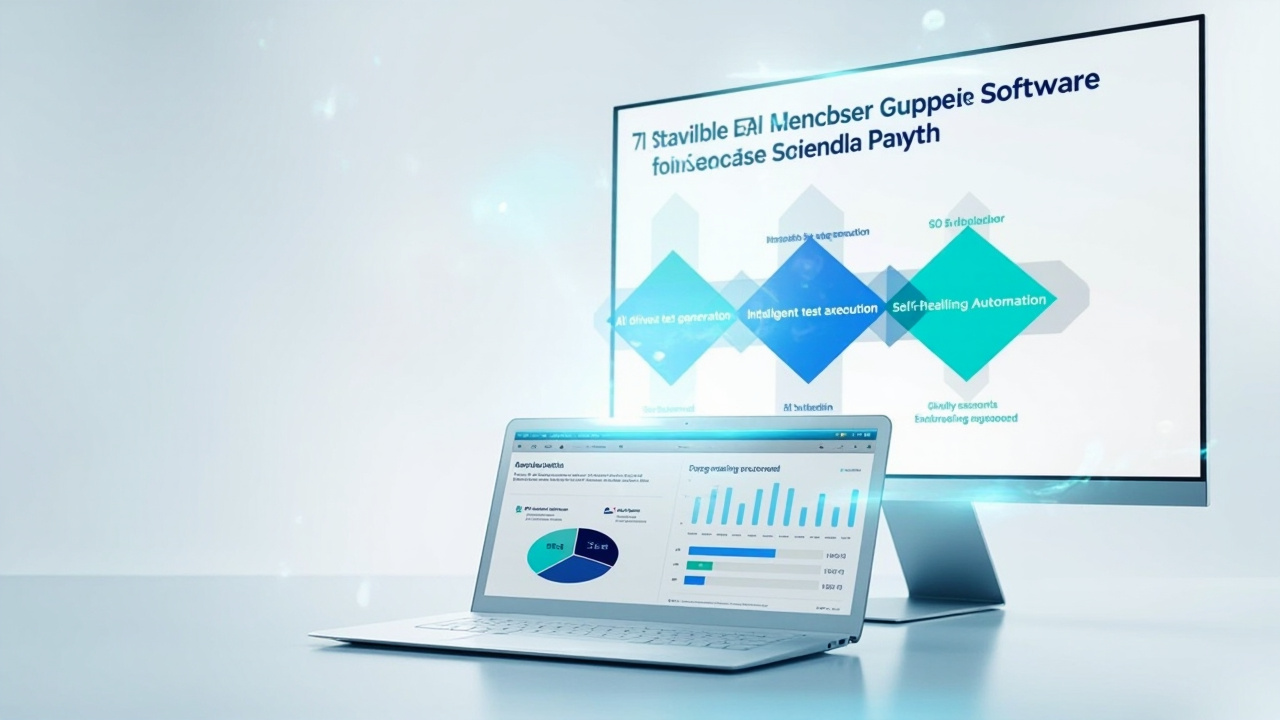In the ever-evolving world of software development, the quest for quality is relentless. As applications become more complex and user expectations rise, software testing has transformed into a crucial component of the development lifecycle. However, traditional testing methods are being challenged by the rapid pace of change, leaving teams grappling with how to ensure robust software quality in an era defined by agility and innovation.
For many years, the software industry has relied on manual testing and early-stage automation tools to identify defects. While these methods have served well in the past, they are increasingly proving insufficient for today’s dynamic development environments. With the rise of Continuous Integration and Continuous Deployment (CI/CD) practices, the need for faster, more efficient testing solutions has never been greater.
Enter advanced tools like GenQE, which are redefining the paradigms of software testing. Leveraging artificial intelligence and machine learning, these platforms are not just enhancing testing efficiency but revolutionizing the entire quality assurance process. In this article, we will explore the multifaceted world of software testing, examining its evolution, current challenges, and the innovative solutions driving the future.
The Foundations of Software Testing: From Manual to Automated

Software testing has a rich history, evolving alongside the technological advancements of the past few decades. Initially, testing was a manual process, heavily reliant on human intervention to identify and rectify errors. While this method allowed for meticulous inspection, it was time-consuming and prone to human error.
The Rise of Automated Testing
As the complexity of software systems grew, the industry witnessed the advent of automated testing tools. These tools aimed to reduce the manual effort required, speeding up the testing process and enhancing accuracy. Automated testing became a game-changer, allowing for repetitive tests to be conducted swiftly and consistently.
“Automated testing transformed the landscape, enabling teams to focus on more strategic aspects of quality assurance.”
The introduction of frameworks like Selenium and JUnit marked a significant shift in how software was tested. These tools provided developers with the ability to write test scripts that could be executed repeatedly, ensuring consistent results and freeing up valuable time.
Yet, despite the advantages, automated testing also presented its own set of challenges. Maintaining test scripts, particularly in dynamic environments where UI elements frequently change, became a resource-intensive task. This is where next-generation solutions like GenQE come into play, offering self-healing capabilities that automatically adjust scripts, reducing maintenance burdens.
The Role of Human Insight
While automation has brought about significant improvements, the human element remains indispensable in testing. Exploratory testing, driven by human intuition and creativity, continues to play a critical role in identifying unforeseen issues. It complements automated efforts by uncovering defects that scripted tests might miss.
The balance between automated and manual testing is a delicate one, requiring strategic planning and execution. As we delve deeper into the world of software testing, we will explore how modern solutions are blurring the lines between these methodologies, creating a more cohesive and efficient testing landscape.
Current Challenges in Software Testing

In today’s fast-paced development cycles, software testing faces numerous challenges that can impede the delivery of high-quality products. Understanding these obstacles is crucial for teams aiming to optimize their testing strategies and deliver seamless user experiences.
Complexity and Scale
Modern software applications are more complex than ever before, often comprising multiple layers of interconnected components. This complexity is further compounded by the need to ensure compatibility across diverse platforms, devices, and operating systems. As a result, achieving comprehensive test coverage becomes a daunting task.
“The complexity of modern applications demands a testing strategy as sophisticated as the software itself.”
To tackle this challenge, solutions like GenQE provide extensive test coverage across various environments, ensuring that applications function seamlessly regardless of where they are deployed. By leveraging AI-driven test generation, these platforms can create test cases that cover a broad spectrum of scenarios, reducing the risk of critical issues slipping through the cracks.
The Pressure of Speed
With the adoption of agile methodologies and CI/CD pipelines, the pressure to deliver software quickly has intensified. This has resulted in shorter testing windows, often leaving teams scrambling to conduct thorough tests before deployment. The need for speed can sometimes come at the cost of quality, leading to potential defects being overlooked.
AI-powered platforms like GenQE address this issue by optimizing test execution. By intelligently prioritizing test cases based on risk analysis, these tools ensure that critical areas are tested first, allowing teams to focus their efforts where they matter most.
Resource Constraints
Limited resources, both in terms of personnel and technology, can hinder effective testing. Many organizations face challenges in scaling their testing efforts to match the demands of their development cycles. Additionally, maintaining test scripts and infrastructure can be resource-intensive, diverting valuable time and effort away from core development tasks.
Innovative solutions offer scalability and integration capabilities that enable seamless incorporation into existing development pipelines. By automating repetitive tasks and providing advanced analytics, these platforms free up resources, allowing teams to concentrate on innovation and strategic initiatives.
The Role of AI in Modern Software Testing

Artificial Intelligence (AI) is reshaping the software testing landscape, offering capabilities that were once considered science fiction. By harnessing the power of machine learning and data analytics, AI-driven testing platforms are enhancing efficiency, accuracy, and adaptability.
AI-Driven Test Generation
One of the most significant contributions of AI to software testing is the automation of test case creation. Traditional methods of designing test cases can be labor-intensive and time-consuming. AI-driven platforms like GenQE analyze software requirements, user behavior, and historical data to automatically generate test cases.
“AI-driven test generation reduces dependency on manual efforts, ensuring broader coverage and faster execution.”
This process not only accelerates the testing phase but also improves coverage by identifying potential scenarios that might have been overlooked by human testers. By continuously learning from data, AI systems can adapt to changes in the software environment, creating a more resilient testing strategy.
Smart Test Execution
AI platforms excel in optimizing test execution by prioritizing test cases based on risk analysis. This ensures that high-impact areas are assessed first, focusing resources on identifying and resolving critical defects early in the development cycle. Such a strategic approach minimizes the risk of defects reaching production, enhancing overall software quality.
The ability to intelligently execute tests is particularly beneficial in environments where time is of the essence. By streamlining the process, AI-driven solutions allow for more frequent releases without compromising on quality, aligning with the demands of agile and DevOps practices.
Self-Healing Automation
A significant pain point in automated testing is the maintenance of test scripts. Changes in UI elements can lead to broken scripts, requiring constant updates and revisions. Platforms like GenQE offer self-healing capabilities, automatically adjusting scripts in response to changes, thus reducing downtime and maintenance efforts.
This feature is a game-changer for teams operating in dynamic environments, where rapid changes are a norm. By minimizing the time spent on maintenance, self-healing automation allows testers to focus on more strategic tasks, enhancing overall productivity.
Ensuring Comprehensive Test Coverage

Achieving comprehensive test coverage is a critical objective for any software testing strategy. It ensures that all aspects of an application are thoroughly examined, reducing the likelihood of defects and enhancing user satisfaction. However, comprehensive coverage can be challenging to attain, especially in complex environments.
Multiplatform Testing
Today’s applications are expected to perform seamlessly across a variety of platforms, including web, mobile, APIs, and cloud environments. Ensuring consistent functionality across these platforms is essential for delivering a positive user experience.
“Comprehensive test coverage is about more than just quantity; it’s about ensuring quality across every platform and device.”
AI-powered platforms like GenQE provide extensive coverage across multiple environments, allowing teams to test applications in diverse settings without the need for separate tools or frameworks. This integrated approach simplifies the testing process and ensures that all potential issues are identified and addressed.
Functional and Non-Functional Testing
While functional testing is crucial for verifying that an application performs its intended functions, non-functional testing is equally important. This includes testing for performance, security, usability, and more. Ensuring comprehensive coverage means addressing both functional and non-functional aspects of the software.
Advanced testing solutions offer capabilities for both types of testing, providing a holistic view of software quality. By integrating performance and security testing into the overall strategy, teams can ensure that their applications not only work as expected but also deliver a secure and efficient user experience.
Continuous Testing in CI/CD Pipelines
In CI/CD environments, continuous testing is essential for maintaining software quality. Automated testing tools must be capable of integrating seamlessly into these pipelines, allowing for continuous feedback and rapid iteration.
Platforms like GenQE are designed with CI/CD integration in mind, enabling automated tests to be part of the development pipeline. This continuous approach ensures that testing is an ongoing process, reducing the risk of defects and accelerating time to market.
The Importance of Defect Detection and Prevention

Detecting and preventing defects early in the development cycle is a fundamental goal of effective software testing. By identifying issues before they escalate, teams can avoid costly rework and ensure a smoother path to production.
Proactive Defect Detection
Traditional testing methods often focus on detecting defects after they have occurred. However, a proactive approach to defect detection can significantly enhance software quality. AI-driven platforms like GenQE leverage machine learning to identify patterns in test results, detecting anomalies and potential defects early in the development cycle.
“Proactive defect detection is key to preventing critical issues from reaching production and impacting users.”
This proactive approach enables teams to address issues before they escalate, reducing the risk of costly rework and ensuring a smoother transition to production. By continuously analyzing data, AI systems can evolve to identify new patterns, enhancing their ability to detect defects over time.
Root Cause Analysis
Understanding the root cause of defects is essential for preventing them from recurring. Advanced testing platforms offer capabilities for root cause analysis, providing insights into the underlying issues that lead to defects. This information is invaluable for teams looking to improve their development processes and enhance software quality.
By identifying the root cause, teams can implement targeted improvements, reducing the likelihood of similar defects occurring in the future. This strategic approach not only enhances software quality but also improves overall development efficiency.
Continuous Improvement
Effective defect detection and prevention are part of a broader strategy of continuous improvement. By consistently analyzing test results and feedback, teams can refine their testing strategies and development processes, ensuring that software quality continually evolves.
AI-driven platforms provide detailed analytics and reporting, offering insights into software quality trends and recommendations for improvement. By leveraging these insights, teams can make informed decisions, driving continuous improvement and maintaining a competitive edge in the marketplace.
Integrating Testing into DevOps and Agile Practices

The integration of testing into DevOps and agile practices is essential for maintaining software quality in today’s fast-paced development environments. By embedding testing throughout the development lifecycle, teams can ensure that quality is a continuous focus.
The Role of Testing in DevOps
In DevOps, the focus is on collaboration and integration between development and operations teams. Testing plays a critical role in this process, providing continuous feedback and ensuring that software quality is maintained throughout the development lifecycle.
“In DevOps, testing is not just a phase; it’s an integral part of the entire lifecycle, driving continuous improvement.”
Automated testing tools like GenQE integrate seamlessly into DevOps pipelines, enabling continuous testing and feedback. This integration ensures that testing is a collaborative effort, involving all stakeholders and driving continuous improvement.
Agile Testing Practices
Agile methodologies emphasize flexibility and rapid iteration, making testing a crucial component of the development process. Agile testing practices focus on early and continuous testing, ensuring that issues are identified and addressed quickly.
AI-driven testing platforms support agile practices by providing rapid test execution and feedback. By automating repetitive tasks, these tools free up teams to focus on more strategic aspects of testing, enhancing overall productivity and efficiency.
Collaboration and Communication
Effective testing in DevOps and agile environments requires collaboration and communication between all team members. By fostering a culture of collaboration, teams can ensure that testing is a shared responsibility, driving continuous improvement and enhancing software quality.
Testing platforms provide collaboration features, enabling teams to share insights and feedback easily. This collaborative approach ensures that all stakeholders are aligned, driving continuous improvement and maintaining a focus on quality.
The Future of Software Testing: Embracing Innovation

As we look to the future, the landscape of software testing is poised for continued innovation and evolution. Emerging technologies and methodologies are set to redefine how testing is conducted, offering new possibilities and opportunities for enhancing software quality.
The Impact of AI and Machine Learning
AI and machine learning are set to play an increasingly prominent role in the future of software testing. As these technologies continue to evolve, they will offer new capabilities for automating and optimizing the testing process.
“The future of software testing is defined by innovation, driven by AI and machine learning.”
Platforms like GenQE are at the forefront of this innovation, leveraging AI to enhance test automation and efficiency. By continuously learning from data, these platforms can adapt to changes in the software environment, creating a more resilient and effective testing strategy.
The Rise of Continuous Testing
Continuous testing is set to become a standard practice in modern development environments. By embedding testing throughout the development lifecycle, teams can ensure that quality is a continuous focus, reducing the risk of defects and accelerating time to market.
AI-driven platforms support continuous testing by providing rapid test execution and feedback. This continuous approach ensures that testing is an ongoing process, driving continuous improvement and enhancing software quality.
Embracing Change and Innovation
The future of software testing is one of change and innovation. By embracing new technologies and methodologies, teams can enhance their testing strategies and maintain a competitive edge in the marketplace.
Innovative solutions like GenQE offer a glimpse into the future, providing advanced capabilities that redefine how testing is conducted. By leveraging these solutions, teams can ensure that they are well-prepared for the challenges and opportunities of the future.
In conclusion, the landscape of software testing is one of continuous evolution and innovation. As the complexity of software systems grows and user expectations rise, the need for advanced testing solutions becomes increasingly apparent. By embracing new technologies like AI and machine learning, and integrating testing into DevOps and agile practices, teams can enhance their testing strategies and ensure robust software quality.
For organizations looking to optimize their testing efforts and maintain a competitive edge, exploring innovative solutions like GenQE can offer valuable opportunities for improvement and growth. As the future of software testing unfolds, the focus will remain on delivering high-quality applications that meet the needs and expectations of users worldwide.
Discover More Innovative Solutions
Want to learn more about the tools and technologies discussed in this article? Explore how these innovations can be tailored to your specific needs and workflow requirements.
Our team of experts is available to answer your questions and provide personalized insights into how modern solutions like GenQE can address your specific challenges.
If the link above does not work, please visit: https://calendly.com/dm-csimplifyit/30min?month=2025-05